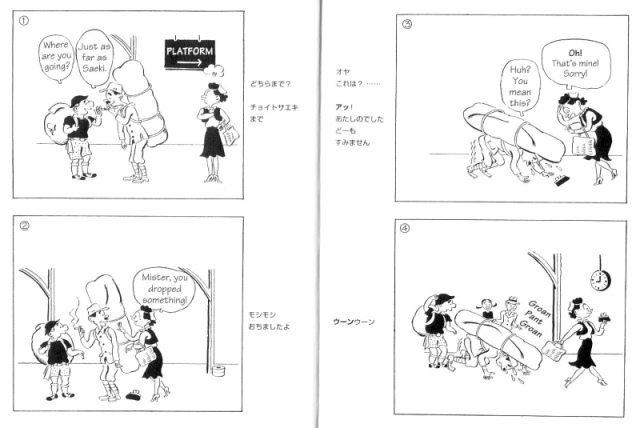“And despite the brittle, choppy process of its creation, when the accumulated three or four days of work speed through the mind in the eight to ten seconds it takes to read, it will all, hopefully, acquire a peculiar fluidity, seeming to come ‘alive,’ right there on the printed page.” — Chris Ware, from his Introduction to McSweeney’s Quarterly Concern, No. 13.
Chris Ware goes through a pained description of the creative process of the cartoonist, spending hours on just one or two panels building into a process spanning days, and then he sums up the product of that work as passing through the mind of a reader in seconds, mere seconds in which the artist hopes the piece comes to life.
Just the other day, my kid asked me if I understood a comic strip from the Sunday funnies. I hadn’t read it yet, and by the time I did and made sense of it, his nine year old attention span had moved on to other imaginative adventures.
A couple months ago, I read the following Sazae-san yonkoma by Machiko Hasegawa:

At the time, I was reading through Hasegawa’s volume at a pace akin to what I used to apply to the Peanuts volumes I used to check out from my elementary school library. I thought I had understood the four panels and didn’t reflect on it further, quickly turning the page. My reading of two months ago went thus: Sazae-san tries to be helpful, but much to her chagrin she has instead created a problem. That fits with the sub-genre, such that the fourth panel in a yonkoma usually offers a comedic twist or turn.
I was flipping through Hasegawa’s volume again the other day, and I was struck by my previous misreading. I now noticed the cloud/steam rising from Sazae-san’s head, which along with her facial expression connotes disapproval. At least one of the men is a foreigner, possibly both are tourists, and both of them are smoking–all or some of which may be contributing factors to her disapproval. And I now see that she’s reaching into her vest and there is no item yet on the ground in the first frame. This yonkoma breaks with form insofar as there’s no actual twist or turn; Sazae-san comes across not as hapless (as I may have initially perceived her) but as sly and intentional.
The time we often spend on understanding comics is perhaps a by-product of the larger cultural assumptions about their value. Perhaps the next time we encounter a comic that proves baffling, we may want to spend more time with it instead of dismissing it, and those comics that we think we already know well, perhaps we should read again. I know I will.

Get yourself a copy of one of the Far Side Gallery books. Nearly every comic from Gary Larson requires you to pay close attention to their contents. I know they greatly improved my observation skills because it can be so easy to miss what each page is trying to say.
LikeLike